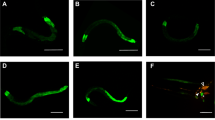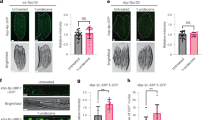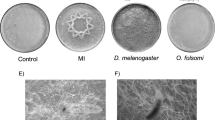Abstract
After being infected by the fungus Drechmeria coniospora, Caenorhabditis elegans produces antimicrobial peptides in its epidermis, some regulated by a signaling cascade involving a p38 mitogen-activated protein kinase. Here we show that infection-induced expression of peptides of the Caenacin family occurred independently of the p38 pathway. The caenacin (cnc) genes enhanced survival after fungal infection, and neuronal expression of the transforming growth factor-β homolog DBL-1 promoted cnc-2 expression in the epidermis in a dose-dependent paracrine way. Our results lead to a model in which antifungal defenses are coordinately regulated by a cell-autonomous p38 cascade and a distinct cytokine-like transforming growth factor-β signal from the nervous system, each of which controls distinct sets of antimicrobial peptide–encoding genes in the epidermis.
This is a preview of subscription content, access via your institution
Access options
Subscribe to this journal
Receive 12 print issues and online access
$209.00 per year
only $17.42 per issue
Buy this article
- Purchase on Springer Link
- Instant access to full article PDF
Prices may be subject to local taxes which are calculated during checkout








Similar content being viewed by others
References
Tan, M.W. & Ausubel, F.M. Caenorhabditis elegans: a model genetic host to study Pseudomonas aeruginosa pathogenesis. Curr. Opin. Microbiol. 3, 29–34 (2000).
Ewbank, J.J. Tackling both sides of the host-pathogen equation with Caenorhabditis elegans. Microbes Infect. 4, 247–256 (2002).
Sifri, C.D., Begun, J. & Ausubel, F.M. The worm has turned–microbial virulence modeled in Caenorhabditis elegans. Trends Microbiol. 13, 119–127 (2005).
Gravato-Nobre, M.J. & Hodgkin, J. Caenorhabditis elegans as a model for innate immunity to pathogens. Cell. Microbiol. 7, 741–751 (2005).
Zhang, Y. Neuronal mechanisms of Caenorhabditis elegans and pathogenic bacteria interactions. Curr. Opin. Microbiol. 11, 257–261 (2008).
Schulenburg, H. & Ewbank, J.J. The genetics of pathogen avoidance in Caenorhabditis elegans. Mol. Microbiol. 66, 563–570 (2007).
Shivers, R.P., Youngman, M.J. & Kim, D.H. Transcriptional responses to pathogens in Caenorhabditis elegans. Curr. Opin. Microbiol. 11, 251–256 (2008).
Schulenburg, H., Kurz, C.L. & Ewbank, J.J. Evolution of the innate immune system: the worm perspective. Immunol. Rev. 198, 36–58 (2004).
Nicholas, H.R. & Hodgkin, J. Responses to infection and possible recognition strategies in the innate immune system of Caenorhabditis elegans. Mol. Immunol. 41, 479–493 (2004).
Pujol, N. et al. A reverse genetic analysis of components of the Toll signalling pathway in Caenorhabditis elegans. Curr. Biol. 11, 809–821 (2001).
Pradel, E. et al. Detection and avoidance of a natural product from the pathogenic bacterium Serratia marcescens by Caenorhabditis elegans. Proc. Natl. Acad. Sci. USA 104, 2295–2300 (2007).
Tenor, J.L. & Aballay, A. A conserved Toll-like receptor is required for Caenorhabditis elegans innate immunity. EMBO Rep. 9, 103–109 (2008).
Haskins, K.A., Russell, J.F., Gaddis, N., Dressman, H.K. & Aballay, A. Unfolded protein response genes regulated by CED-1 are required for Caenorhabditis elegans innate immunity. Dev. Cell 15, 87–97 (2008).
Couillault, C. et al. TLR-independent control of innate immunity in Caenorhabditis elegans by the TIR domain adaptor protein TIR-1, an ortholog of human SARM. Nat. Immunol. 5, 488–494 (2004).
Pujol, N. et al. Distinct innate immune responses to infection and wounding in the C. elegans epidermis. Curr. Biol. 18, 481–489 (2008).
Pujol, N. et al. Anti-fungal innate immunity in C. elegans is enhanced by evolutionary diversification of antimicrobial peptides. PLoS Pathog. 4, e1000105 (2008).
Dijksterhuis, J., Veenhuis, M. & Harder, W. Ultrastructural study of adhesion and initial stages of infection of the nematode by conidia of Drechmeria coniospora. Mycol. Res. 94, 1–8 (1990).
Nicholas, H.R. & Hodgkin, J. The ERK MAP kinase cascade mediates tail swelling and a protective response to rectal infection in C. elegans. Curr. Biol. 14, 1256–1261 (2004).
Mallo, G.V. et al. Inducible antibacterial defense system in C. elegans. Curr. Biol. 12, 1209–1214 (2002).
Tan, M.W. Genetic and genomic dissection of host-pathogen interactions using a P. aeruginosa-C. elegans pathogenesis model. Pediatr. Pulmonol. 32, 96–97 (2001).
Morita, K., Chow, K.L. & Ueno, N. Regulation of body length and male tail ray pattern formation of Caenorhabditis elegans by a member of TGF-beta family. Development 126, 1337–1347 (1999).
Suzuki, Y. et al. A BMP homolog acts as a dose-dependent regulator of body size and male tail patterning in Caenorhabditis elegans. Development 126, 241–250 (1999).
Savage, C. et al. Caenorhabditis elegans genes sma-2, sma-3, and sma-4 define a conserved family of transforming growth factor beta pathway components. Proc. Natl. Acad. Sci. USA 93, 790–794 (1996).
Savage-Dunn, C. TGF-β signaling. WormBook (ed. The C. elegans Research Community) doi/10.1895/wormbook.1.22.1 (9 September 2005).
Schmierer, B. & Hill, C.S. TGFβ-SMAD signal transduction: molecular specificity and functional flexibility. Nat. Rev. Mol. Cell Biol. 8, 970–982 (2007).
Reboul, J. et al. C. elegans ORFeome version 1.1: experimental verification of the genome annotation and resource for proteome-scale protein expression. Nat. Genet. 34, 35–41 (2003).
Watanabe, N., Ishihara, T. & Ohshima, Y. Mutants carrying two sma mutations are super small in the nematode C. elegans. Genes Cells 12, 603–609 (2007).
Savage-Dunn, C. et al. Genetic screen for small body size mutants in C. elegans reveals many TGFβ pathway components. Genesis 35, 239–247 (2003).
Gumienny, T.L. et al. Glypican LON-2 is a conserved negative regulator of BMP-like signaling in Caenorhabditis elegans. Curr. Biol. 17, 159–164 (2007).
Mochii, M., Yoshida, S., Morita, K., Kohara, Y. & Ueno, N. Identification of transforming growth factor-β-regulated genes in Caenorhabditis elegans by differential hybridization of arrayed cDNAs. Proc. Natl. Acad. Sci. USA 96, 15020–15025 (1999).
Lemaitre, B. & Hoffmann, J. The host defense of Drosophila melanogaster. Annu. Rev. Immunol. 25, 697–743 (2007).
Imler, J.L. & Bulet, P. Antimicrobial peptides in Drosophila: structures, activities and gene regulation. Chem. Immunol. Allergy 86, 1–21 (2005).
Fehlbaum, P. et al. Insect immunity. Septic injury of Drosophila induces the synthesis of a potent antifungal peptide with sequence homology to plant antifungal peptides. J. Biol. Chem. 269, 33159–33163 (1994).
Murray-Rust, J. et al. Topological similarities in TGF-β2, PDGF-BB and NGF define a superfamily of polypeptide growth factors. Structure 1, 153–159 (1993).
Lemaitre, B., Nicolas, E., Michaut, L., Reichhart, J.M. & Hoffmann, J.A. The dorsoventral regulatory gene cassette spatzle/Toll/cactus controls the potent antifungal response in Drosophila adults. Cell 86, 973–983 (1996).
Irving, P. et al. A genome-wide analysis of immune responses in Drosophila. Proc. Natl. Acad. Sci. USA 98, 15119–15124 (2001).
De Gregorio, E., Spellman, P.T., Rubin, G.M. & Lemaitre, B. Genome-wide analysis of the Drosophila immune response by using oligonucleotide microarrays. Proc. Natl. Acad. Sci. USA 98, 12590–12595 (2001).
Jang, I.H. et al. A Spatzle-processing enzyme required for toll signaling activation in Drosophila innate immunity. Dev. Cell 10, 45–55 (2006).
Schwartz, M.A. & Madhani, H.D. Principles of MAP kinase signaling specificity in Saccharomyces cerevisiae. Annu. Rev. Genet. 38, 725–748 (2004).
Chuang, C.F. & Bargmann, C.I.A. Toll-interleukin 1 repeat protein at the synapse specifies asymmetric odorant receptor expression via ASK1 MAPKKK signaling. Genes Dev. 19, 270–281 (2005).
Kim, D.H. et al. A conserved p38 MAP kinase pathway in Caenorhabditis elegans innate immunity. Science 297, 623–626 (2002).
Kurz, C.L. & Tan, M.W. Regulation of aging and innate immunity in C. elegans. Aging Cell 3, 185–193 (2004).
Kawli, T. & Tan, M.W. Neuroendocrine signals modulate the innate immunity of Caenorhabditis elegans through insulin signaling. Nat. Immunol. 9, 1415–1424 (2008).
Liang, B., Moussaif, M., Kuan, C.J., Gargus, J.J. & Sze, J.Y. Serotonin targets the DAF-16/FOXO signaling pathway to modulate stress responses. Cell Metab. 4, 429–440 (2006).
Reddy, K.C., Andersen, E.C., Kruglyak, L. & Kim, D.H. A polymorphism in npr-1 is a behavioral determinant of pathogen susceptibility in. C. elegans. Science 323, 382–384 (2009).
Baumeister, R., Schaffitzel, E. & Hertweck, M. Endocrine signaling in Caenorhabditis elegans controls stress response and longevity. J. Endocrinol. 190, 191–202 (2006).
Evans, E.A., Kawli, T. & Tan, M.W. Pseudomonas aeruginosa suppresses host immunity by activating the DAF-2 insulin-like signaling pathway in Caenorhabditis elegans. PLoS Pathog. 4, e1000175 (2008).
Apidianakis, Y. et al. Profiling early infection responses: Pseudomonas aeruginosa eludes host defenses by suppressing antimicrobial peptide gene expression. Proc. Natl. Acad. Sci. USA 102, 2573–2578 (2005).
Chamilos, G. et al. Drosophila melanogaster as a model host to dissect the immunopathogenesis of zygomycosis. Proc. Natl. Acad. Sci. USA 105, 9367–9372 (2008).
Timmons, L., Court, D.L. & Fire, A. Ingestion of bacterially expressed dsRNAs can produce specific and potent genetic interference in Caenorhabditis elegans. Gene 263, 103–112 (2001).
Acknowledgements
We thank A. Chisholm, P. Golstein, J. Hodgkin, J.-L. Imler and members of the Ewbank laboratory for discussion and comments on the manuscript, and R.W. Padgett (Rutgers University) for the wt;ctIs40 strain; some other nematode strains were provided by the Caenorhabditis Genetics Center (funded by the National Institutes of Health National Center for Research Resources) or by the National Bioresource Project coordinated by S. Mitani (Tokyo Women's Medical University School of Medicine). Worm sorter analyses were done in the facilities of Marseille-Nice Genopole. Supported by the Institut National de la Santé et de la Recherche Médicale, Centre National de la Recherche Scientifique, the Agence National de Recherches (Droselegans, Fungenomics) and Union Biometrica. The Ewbank lab is an Équipe Labellisée Fondation pour la Recherche Médicale.
Author information
Authors and Affiliations
Contributions
O.Z. and J.J.E. designed the experiments, interpreted the data and wrote the manuscript, and O.Z. did the experimental studies.
Corresponding author
Supplementary information
Supplementary Text and Figures
Supplementary Figures 1–13, Table 1 and Supplementary Methods (PDF 7295 kb)
Rights and permissions
About this article
Cite this article
Zugasti, O., Ewbank, J. Neuroimmune regulation of antimicrobial peptide expression by a noncanonical TGF-β signaling pathway in Caenorhabditis elegans epidermis. Nat Immunol 10, 249–256 (2009). https://doi.org/10.1038/ni.1700
Received:
Accepted:
Published:
Issue Date:
DOI: https://doi.org/10.1038/ni.1700
This article is cited by
-
Bone morphogenetic protein signaling regulation of AMPK and PI3K in lung cancer cells and C. elegans
Cell & Bioscience (2022)
-
Weissella confusa CGMCC 19,308 Strain Protects Against Oxidative Stress, Increases Lifespan, and Bacterial Disease Resistance in Caenorhabditis elegans
Probiotics and Antimicrobial Proteins (2022)
-
From wound response to repair – lessons from C. elegans
Cell Regeneration (2021)
-
The TGF-β ligand DBL-1 is a key player in a multifaceted probiotic protection against MRSA in C. elegans
Scientific Reports (2021)
-
Probiotics Interactions and the Modulation of Major Signalling Pathways in Host Model Organism Caenorhabditis elegans
Indian Journal of Microbiology (2021)



